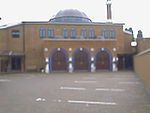Captain's Wood, Buckinghamshire
Local Nature Reserves in BuckinghamshireUse British English from January 2020

Captain's Wood is a 13.9 hectares (34 acres) Local Nature Reserve near Chesham in Buckinghamshire. It is owned by Buckinghamshire County Council and the Chiltern Society took over management of the site from the Council in 2014. It is part of the Chilterns Area of Outstanding Natural Beauty.The site is ancient beech woodland which has high ecological value. In spring it is carpeted with bluebells.There is access from Mount Nugent.
Excerpt from the Wikipedia article Captain's Wood, Buckinghamshire (License: CC BY-SA 3.0, Authors, Images).Captain's Wood, Buckinghamshire
CHS/77/2 and CHS/77/1,
Geographical coordinates (GPS) Address Nearby Places Show on map
Geographical coordinates (GPS)
| Latitude | Longitude |
|---|---|
| N 51.721728 ° | E -0.625377 ° |
Address
CHS/77/2 and CHS/77/1
CHS/77/2 and CHS/77/1
HP5 2QH , Chesham (Chesham and Villages Community Board)
England, United Kingdom
Open on Google Maps









